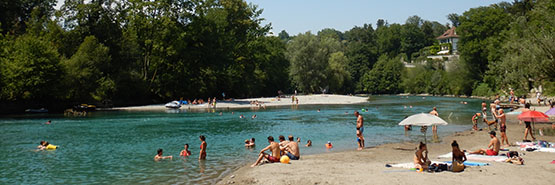Thanks to various protective measures and major advances in wastewater treatment in recent decades, water quality in Swiss rivers and lakes is now very high and virtually all are clean enough to swim in.

The FOEN and the Federal Office of Public Health (FOPH) have issued recommendations for analysing and assessing bathing water quality in rivers and lakes. Intended as an implementation guide for the cantons, the recommendations are based on the 2006 EU Bathing Water Directive and supersede the previous recommendations on the hygiene assessment of lake and river bathing waters, which dated from 1991.
The implementation guide sets out the legal bases and details the latest methods and procedures for analysing and assessing bathing water quality.
Assessing bathing water quality in rivers and lakes
The FOEN collates the cantonal data and makes it available for national reports. It also forwards the data to the European Environment Agency (EEA) for publication in its reports on bathing water quality in Europe.
At map.geo.admin.ch, a map of Switzerland shows bathing places that have been recently assessed, according to the five quality classes used by the EEA.
Recording water data
Bathing water data must be transmitted to the FOEN as laid down in chapter 7 of the new recommendations, using the Excel template provided by the FOEN.
Additional data
Further information
Last modification 26.05.2023





